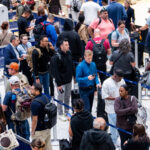It doesn’t surprise experts that some debit and credit card numbers stolen from Target’s computer systems may have surfaced among nearly 100 fake credit cards seized by police in Texas this week.
Even so, they say the bust is unlikely to lead authorities directly to the hackers behind the breach, given the vast, labyrinthine nature of the global market for stolen data.
According to police in McAllen, Texas, two Mexican citizens arrested at the border used account information stolen during the pre- Christmas Target breach to buy tens of thousands of dollars’ worth of merchandise. But the U.S. Secret Service said Tuesday its investigation into the possibility of a link between the Target data theft and the arrests remains ongoing.
Target says hackers stole about 40 million debit and credit card numbers from cards swiped at its stores between Nov. 27 and Dec. 15. The thieves also took personal information – including email addresses, phone numbers, names and home addresses – for another 70 million people.
In the aftermath of the breach, millions of Americans have been left to wonder what’s become of their precious personal information. Chester Wisniewski, senior security adviser for the computer security firm Sophos, says in cases where such a massive amount of information is stolen, criminals generally divide the data into chunks and sell the parcels in online black markets.
In many ways, those markets behave much like any legitimate marketplace ruled by the forces of supply and demand. Groups of higher-end cards are worth significantly more than those with lower credit limits and so are cards tied to additional personal information, such as names, addresses and zip codes, which make them easier to use.
After thieves purchase the numbers, they can encode the data onto new, blank cards with an inexpensive, easy-to-use gadget. Or they can skip the card-writing process and simply use the card numbers online.
Crooks often have the option to buy cards last used in their area. That way, Wisniewski says, the cards attract less attention from the banks that issued them.
According to police, the pair arrested at the U.S.-Mexican border used cards containing the account information of Target shoppers from South Texas. Police say the two used fraudulent cards to purchase numerous items at national retailers in the area.
The underground markets always have a steady supply of card numbers on sale and their locations are always moving as they try to elude law enforcement, says Daniel Ingevaldson, chief technology officer at Easy Solutions Inc., a firm that sells anti-fraud products and tracks the activity of the online black markets. A big jump in inventory usually indicates there’s been a breach of a major retailer. That’s what Ingevaldson’s firm saw in the cases of both Target and Neiman Marcus, which also recently reported a breach.
While many of these online bazaars and forums are based in Russia and Eastern Europe, much of the chatter is in English and appears to have been written by Americans, Ingevaldson says.
The types of criminals who buy the card numbers run the gamut, ranging from purely online white-collar crooks to street gangs.
“In reality, card numbers can be bought by anybody with access to the forums and a few Bitcoins in their pocket,” Ingevaldson says.
Wisniewski says the people who buy card numbers online and produce the fake cards aren’t the ones who try to use them. Using the cards is the riskiest part of the fraud scheme, so the task is usually farmed out to others who are often recruited through spam emails. The recruiters then send them fraudulent debit and credit cards and instruct them to buy large quantities of expensive merchandise or gift cards in exchange for a small percentage of their value.
Card users, once caught, often only have a handler’s email address to share with police, making it nearly impossible to find the recruiters, Wisniewski says.
Both analysts say Russia and former Soviet countries are a hotbed for hackers behind these kinds of schemes. The region has a large population of highly educated computer science professionals and law enforcement is extremely lax when it comes to fraud that occurs overseas and not in the hackers’ home country.
Wisniewski and Ingevaldson also believe the original authors of the malicious software used in the Target breach are likely based in Russia or Eastern Europe, as some reports on the breach have suggested. But it’s unlikely the original programmers do any hacking themselves. They can make a nice living simply selling the code to those who do.
“Keep in mind, it isn’t illegal to write these kind of codes, just to use them,” Wisniewski says. “And selling them is a lot less risky than taking cards into an Apple store.”
Was this article valuable?
Here are more articles you may enjoy.

 Hackers and Crime Rings Teaming up to Steal Cargo, Cyber Firm Says
Hackers and Crime Rings Teaming up to Steal Cargo, Cyber Firm Says  KCC Estimates Privately Insured Losses From Hurricane Melissa Will Hit $2.4 Billion
KCC Estimates Privately Insured Losses From Hurricane Melissa Will Hit $2.4 Billion  US Airlines Cut Flights, With More Cancellations into Next Week
US Airlines Cut Flights, With More Cancellations into Next Week  Death Toll From UPS Plane Crash up to 13, Airport Reopened
Death Toll From UPS Plane Crash up to 13, Airport Reopened 